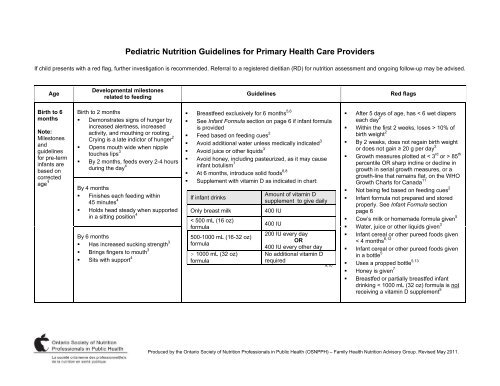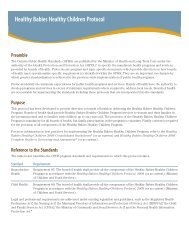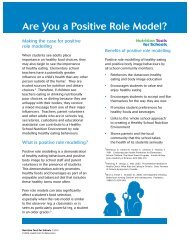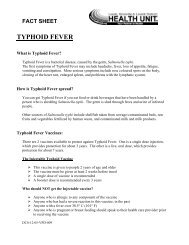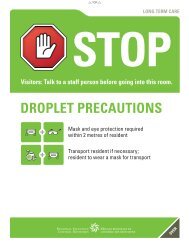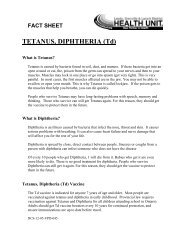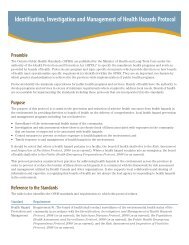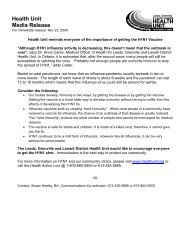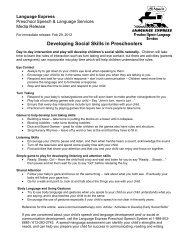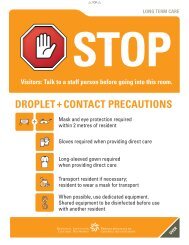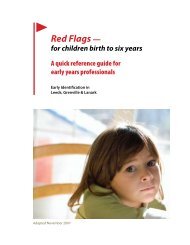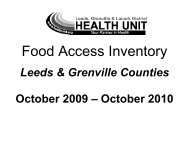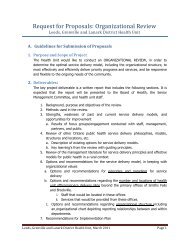Pediatric Nutrition Guidelines for Primary Health Care Providers
Pediatric Nutrition Guidelines for Primary Health Care Providers
Pediatric Nutrition Guidelines for Primary Health Care Providers
You also want an ePaper? Increase the reach of your titles
YUMPU automatically turns print PDFs into web optimized ePapers that Google loves.
<strong>Pediatric</strong> <strong>Nutrition</strong> <strong>Guidelines</strong> <strong>for</strong> <strong>Primary</strong> <strong>Health</strong> <strong>Care</strong> <strong>Providers</strong><br />
If child presents with a red flag, further investigation is recommended. Referral to a registered dietitian (RD) <strong>for</strong> nutrition assessment and ongoing follow-up may be advised.<br />
Age<br />
Developmental milestones<br />
related to feeding<br />
<strong>Guidelines</strong><br />
Red flags<br />
Birth to 6<br />
months<br />
Note:<br />
Milestones<br />
and<br />
guidelines<br />
<strong>for</strong> pre-term<br />
infants are<br />
based on<br />
corrected<br />
age 1<br />
Birth to 2 months<br />
Breastfeed exclusively <strong>for</strong> 6 months 5,6<br />
Demonstrates signs of hunger by See Infant Formula section on page 6 if infant <strong>for</strong>mula<br />
increased alertness, increased<br />
is provided<br />
activity, and mouthing or rooting.<br />
Crying is a late indictor of hunger 2 Feed based on feeding cues 2<br />
Avoid additional water unless medically indicated 3<br />
Opens mouth wide when nipple<br />
touches lips 3<br />
Avoid juice or other liquids 3<br />
By 2 months, feeds every 2-4 hours<br />
Avoid honey, including pasteurized, as it may cause<br />
during the day 4<br />
infant botulism 7<br />
At 6 months, introduce solid foods 6,8<br />
Supplement with vitamin D as indicated in chart:<br />
By 4 months<br />
Finishes each feeding within<br />
Amount of vitamin D<br />
If infant drinks<br />
45 minutes 4<br />
supplement to give daily<br />
Holds head steady when supported Only breast milk<br />
400 IU<br />
in a sitting position 4<br />
< 500 mL (16 oz)<br />
400 IU<br />
<strong>for</strong>mula<br />
By 6 months<br />
200 IU every day<br />
500-1000 mL (16-32 oz)<br />
Has increased sucking strength 3<br />
OR<br />
<strong>for</strong>mula<br />
400 IU every other day<br />
Brings fingers to mouth 3<br />
> 1000 mL (32 oz) No additional vitamin D<br />
Sits with support 4 <strong>for</strong>mula<br />
required<br />
9,10<br />
After 5 days of age, has < 6 wet diapers<br />
each day 2<br />
Within the first 2 weeks, loses > 10% of<br />
birth weight 2<br />
By 2 weeks, does not regain birth weight<br />
or does not gain 20 g per day 2<br />
Growth measures plotted at < 3 rd or > 85 th<br />
percentile OR sharp incline or decline in<br />
growth in serial growth measures, or a<br />
growth-line that remains flat, on the WHO<br />
Growth Charts <strong>for</strong> Canada 11<br />
Not being fed based on feeding cues 2<br />
Infant <strong>for</strong>mula not prepared and stored<br />
properly. See Infant Formula section<br />
page 6<br />
Cow’s milk or homemade <strong>for</strong>mula given 5<br />
Water, juice or other liquids given 3<br />
Infant cereal or other pureed foods given<br />
< 4 months 6,12<br />
Infant cereal or other pureed foods given<br />
in a bottle 5<br />
Uses a propped bottle 5,13<br />
Honey is given 7<br />
Breastfed or partially breastfed infant<br />
drinking < 1000 mL (32 oz) <strong>for</strong>mula is not<br />
receiving a vitamin D supplement 5<br />
Produced by the Ontario Society of <strong>Nutrition</strong> Professionals in Public <strong>Health</strong> (OSNPPH) – Family <strong>Health</strong> <strong>Nutrition</strong> Advisory Group. Revised May 2011.
<strong>Pediatric</strong> <strong>Nutrition</strong> <strong>Guidelines</strong> <strong>for</strong> <strong>Primary</strong> <strong>Health</strong> <strong>Care</strong> <strong>Providers</strong><br />
2<br />
If child presents with a red flag, further investigation is recommended. Referral to a registered dietitian (RD) <strong>for</strong> nutrition assessment and ongoing follow-up may be advised.<br />
Age<br />
Developmental milestones<br />
related to feeding<br />
<strong>Guidelines</strong><br />
Red flags<br />
6 to 9 At about 6 months, is<br />
Continue to breastfeed 2,5<br />
Growth measures plotted at < 3 rd or > 85 th<br />
months<br />
physiologically and<br />
See Infant Formula section on page 6 if infant <strong>for</strong>mula percentile OR sharp incline or decline in<br />
developmentally ready <strong>for</strong><br />
is given<br />
growth in serial growth measures, or a<br />
Note:<br />
solid foods 5<br />
Milestones<br />
Feed based on feeding cues 2<br />
growth-line that remains flat, on the WHO<br />
Sits with minimal support 2<br />
and<br />
At 6 months, introduce iron-rich foods (e.g., iron-<strong>for</strong>tified<br />
Growth Charts <strong>for</strong> Canada 11<br />
guidelines<br />
Has vertical jaw movement<br />
infant cereal, meat, beans, tofu). Note: meat is a highly Has < 6 wet diapers each day 2<br />
<strong>for</strong> pre-term<br />
(munching) with suckling motion by bio-available <strong>for</strong>m of iron and zinc 5<br />
By 7 months, not eating iron-containing<br />
infants are<br />
the tongue while chewing foods 14<br />
Begin to introduce a variety of vegetables, fruit, grains foods daily 5<br />
based on Has some tongue protrusion when and milk products (other than fluid milk) in any<br />
Infant <strong>for</strong>mula not prepared and stored<br />
corrected beginning to eat solid foods which sequence 12<br />
properly. See Infant Formula section<br />
age 1 decreases with experience 14<br />
May introduce highly allergenic foods (e.g., whole eggs, page 6<br />
May still have early gag reflex<br />
milk products, fish, and peanuts) after 6 months Cow’s milk or homemade <strong>for</strong>mula<br />
hindering ingestion of solid foods regardless of family history of allergy 12<br />
is given 5<br />
until its locus moves further toward<br />
Introduce each new food <strong>for</strong> 3-5 days be<strong>for</strong>e<br />
Consumes juice frequently throughout the<br />
the back of the tongue (usually<br />
between 3-7 months of age) 2<br />
introducing another new food to help identify potential day or drinks > 125 mL (4 oz) juice per<br />
food allergies 2<br />
day 3<br />
Indicates desire <strong>for</strong> food by<br />
Offer solid food 2-3 times a day 15<br />
Consumes fruit drinks, pop, coffee, tea,<br />
opening mouth or leaning in, and<br />
satiety by closing mouth or turning<br />
Breastfeed be<strong>for</strong>e offering solid foods to sustain breast hot chocolate, soy beverage, other<br />
away 2 . See Parenting and the<br />
milk supply and to ensure breast milk continues to be vegetarian beverages (e.g., rice or almond<br />
feeding relationship section on<br />
the major source of energy and nutrients 15<br />
beverage) or herbal teas 5<br />
page 7<br />
Breast milk, infant <strong>for</strong>mula, water and 100% fruit juice Infant cereal or other pureed foods given<br />
Begins to feed self by holding small<br />
are the only acceptable beverage options 5<br />
in a bottle 5<br />
foods between thumb and <strong>for</strong>e If juice is given, limit to 60-125 mL (2-4 oz) 3<br />
Uses a propped bottle 5<br />
finger 2 Offer a cup regularly 16<br />
Honey is given 7<br />
yolk; <strong>for</strong>tified margarine - 25 IU in 5 mL (1 tsp) 10<br />
Avoid honey, including pasteurized, as it may cause Feeding is <strong>for</strong>ced or restricted 2<br />
infant botulism 7<br />
Breastfed or partially breastfed infants<br />
Gradually increase texture of foods from pureed to<br />
drinking < 1000 mL (32 oz) <strong>for</strong>mula is not<br />
lumpy to small pieces 14<br />
receiving a vitamin D supplement 5<br />
Give breastfed infants a vitamin D supplement of 400 IU<br />
daily until the infant’s diet includes 400 IU per day of<br />
vitamin D from other dietary sources. Food sources of<br />
vitamin D include: <strong>for</strong>tified infant <strong>for</strong>mula - 100 IU in<br />
250 mL (1 cup); cow’s milk - 100 IU in 250 mL (1 cup);<br />
salmon - 103 IU in 30 g (1 oz); egg yolk - 25 IU in one<br />
Produced by the Ontario Society of <strong>Nutrition</strong> Professionals in Public <strong>Health</strong> (OSNPPH) – Family <strong>Health</strong> <strong>Nutrition</strong> Advisory Group. Revised May 2011.
<strong>Pediatric</strong> <strong>Nutrition</strong> <strong>Guidelines</strong> <strong>for</strong> <strong>Primary</strong> <strong>Health</strong> <strong>Care</strong> <strong>Providers</strong><br />
3<br />
If child presents with a red flag, further investigation is recommended. Referral to a registered dietitian (RD) <strong>for</strong> nutrition assessment and ongoing follow-up may be advised.<br />
Age<br />
Developmental milestones<br />
related to feeding<br />
<strong>Guidelines</strong><br />
Red flags<br />
9 to 12<br />
Uses jaw and tongue to bite and Continue to breastfeed 2,5<br />
Has < 6 wet diapers each day 2<br />
months<br />
mash a variety of textures 17 See Infant Formula section on page 6 if infant <strong>for</strong>mula Growth measures plotted at < 3 rd or > 85 th<br />
Note:<br />
Tries to use a spoon 3<br />
is given<br />
percentile OR sharp incline or decline in<br />
Milestones May demand to spoon-feed self 17 Feed based on feeding cues 2<br />
growth in serial growth measures, or a<br />
and<br />
See Parenting and the feeding Offer solid foods 3-4 times per day 15<br />
growth-line that remains flat, on the WHO<br />
guidelines relationship section on page 7 Continue to introduce solid foods in any sequence 15<br />
Growth Charts <strong>for</strong> Canada 11<br />
<strong>for</strong> pre-term Feeds self by holding small foods<br />
By 10 months, lumpy textures not<br />
Gradually increase texture of foods from lumpy to small<br />
infants are between thumb and <strong>for</strong>e finger 2<br />
pieces to encourage acceptance of increased texture 14 consumed 14<br />
based on By 12 months, drinks<br />
Infant <strong>for</strong>mula not prepared and stored<br />
At 9-12 months, preferably 12 months, may introduce<br />
corrected independently from cup with a<br />
age 1 whole (3.25%) cow’s milk 18 properly. See Infant Formula section<br />
. Avoid skim, 1% or 2% milk<br />
spout or straw 5,14 and soy beverages 5<br />
page 6<br />
Skim milk, low fat milk or soy beverage is<br />
By 12 months, if cow’s milk is the primary source of<br />
given as main milk source 5<br />
milk, give 500 mL (2 cups) per day plus other food<br />
sources of vitamin D 2<br />
Consumes juice frequently throughout<br />
the day 3<br />
If juice is given, offer 100% juice and limit to 125-175<br />
mL (4-6 oz) per day 2<br />
Consumes large amount of fluids 2<br />
Offer a cup with breast milk, <strong>for</strong>mula, cow’s milk, water<br />
- Milk: > 750 mL (3 cups) a day 3<br />
or 100% juice 16<br />
- Juice: > 175 mL (6 oz) a day 2,8<br />
milk - 100 IU in 250 mL (1 cup); salmon - 103 IU in 30 Breastfed or partially breastfed infant<br />
g (1 oz); egg yolk - 25 IU in one yolk; <strong>for</strong>tified margarine<br />
- 25 IU in 5 mL (1 tsp) 10 drinking < 1000 mL (32 oz) <strong>for</strong>mula is not<br />
receiving a vitamin D supplement 5<br />
Avoid honey, including pasteurized, as it may cause Consumes fruit drinks, pop, coffee, tea,<br />
infant botulism 7<br />
cola, hot chocolate, soy beverage, other<br />
Give breastfed infant a vitamin D supplement of 400 IU<br />
vegetarian beverages (e.g., rice or almond<br />
daily until the infant’s diet includes 400 IU per day of<br />
beverage) or herbal teas 5<br />
vitamin D from other dietary sources or until the infant Honey is given 7<br />
reaches 1 year. Food sources of vitamin D include: Feeding is <strong>for</strong>ced or restricted 2<br />
<strong>for</strong>tified infant <strong>for</strong>mula - 100 IU in 250 mL (1 cup); cow’s Not supervised during feeding 5<br />
Produced by the Ontario Society of <strong>Nutrition</strong> Professionals in Public <strong>Health</strong> (OSNPPH) – Family <strong>Health</strong> <strong>Nutrition</strong> Advisory Group. Revised May 2011.
<strong>Pediatric</strong> <strong>Nutrition</strong> <strong>Guidelines</strong> <strong>for</strong> <strong>Primary</strong> <strong>Health</strong> <strong>Care</strong> <strong>Providers</strong><br />
4<br />
If child presents with a red flag, further investigation is recommended. Referral to a registered dietitian (RD) <strong>for</strong> nutrition assessment and ongoing follow-up may be advised.<br />
Age<br />
Developmental milestones<br />
related to feeding<br />
<strong>Guidelines</strong><br />
Red flags<br />
12 to 24<br />
months<br />
Note:<br />
Milestones<br />
and<br />
guidelines<br />
<strong>for</strong> pre-term<br />
children are<br />
based on<br />
corrected<br />
age 1<br />
12 to 18 months<br />
Growth slows compared with the<br />
first year of life resulting in<br />
decreased or sporadic appetite 2<br />
See Parenting and the feeding<br />
relationship section on page 7<br />
Unfamiliar foods are often rejected<br />
the first time 2<br />
By 15 months, can self-feed with<br />
spoon and firmer table foods 2<br />
18 to 24 months<br />
Able to consume most of the same<br />
foods as the rest of the family with<br />
some extra preparation <strong>for</strong><br />
prevention of choking 2<br />
Fluctuating appetite and playing<br />
with food is common 2 . See<br />
Parenting and the feeding<br />
relationship section on page 7<br />
May refuse all but 4-5 foods,<br />
consume only preferred foods and<br />
refuse previously accepted foods 2 <br />
<br />
<br />
<br />
<br />
<br />
<br />
<br />
<br />
<br />
<br />
Continue to breastfeed 2,5<br />
If not breastfeeding, offer<br />
Avoid skim, 1% or 2% milk<br />
Offer 500-750 mL (2-3 cups)<br />
breast milk each day 3<br />
Serve 3 small meals and<br />
additional food or beverages<br />
planned meals and snacks<br />
Offer water when child is<br />
If juice is provided, offer 100%<br />
mL (4-6 oz) per day 2<br />
Avoid fruit drinks that are<br />
By 15 months, wean from<br />
Allow child to self-feed 2<br />
If breast milk is their only<br />
a vitamin D supplement 2<br />
Consider offering a vitamin/mineral<br />
is not growing well, has a<br />
requires it, and/or is not eating<br />
each of the food groups 2 <br />
<br />
<br />
<br />
<br />
<br />
<br />
<br />
<br />
Growth measures plotted at < 3<br />
percentile OR sharp incline or decline<br />
growth in serial growth measures,<br />
growth-line that remains flat, on<br />
Growth Charts <strong>for</strong> Canada 11<br />
Not eating a variety of table foods<br />
including iron containing foods<br />
Dietary fat intake is restricted 5<br />
Lumpy or textured foods are refused<br />
Skim milk, low fat milk or soy beverage<br />
regularly given 5<br />
Soy (except <strong>for</strong>mula), rice, other<br />
vegetarian beverages or herbal<br />
are given 5<br />
Consumes large amount of fluids<br />
little food 2<br />
- Milk: > 750 mL (3 cups) a day<br />
- Juice: > 175 mL (6 oz) a day<br />
Regularly consumes fruit drinks,<br />
coffee, tea, cola, hot chocolate,<br />
beverage, other vegetarian beverages<br />
(e.g., rice or almond beverage)<br />
teas 2,5<br />
Feeding is <strong>for</strong>ced or restricted 2<br />
not 100% juice and pop 2<br />
bottle 2<br />
teas<br />
and very<br />
milk source, consider offering<br />
supplement if child<br />
specific health condition that<br />
a variety of foods from<br />
pop,<br />
soy<br />
whole (3.25%) cow’s milk. 2,16<br />
in<br />
5<br />
or a<br />
per day of 3.25% milk or<br />
the WHO<br />
2-3 snacks a day 3 . Avoid<br />
except water between<br />
daily 5<br />
2,3<br />
thirsty 2<br />
juice and limit to 125-175<br />
or herbal<br />
Produced by the Ontario Society of <strong>Nutrition</strong> Professionals in Public <strong>Health</strong> (OSNPPH) – Family <strong>Health</strong> <strong>Nutrition</strong> Advisory Group. Revised May 2011.
<strong>Pediatric</strong> <strong>Nutrition</strong> <strong>Guidelines</strong> <strong>for</strong> <strong>Primary</strong> <strong>Health</strong> <strong>Care</strong> <strong>Providers</strong><br />
5<br />
If child presents with a red flag, further investigation is recommended. Referral to a registered dietitian (RD) <strong>for</strong> nutrition assessment and ongoing follow-up may be advised.<br />
Age<br />
Developmental milestones<br />
related to feeding<br />
<strong>Guidelines</strong><br />
Red flags<br />
May continue to breastfeed 5<br />
2 to 6 years Eats most foods without coughing Follow Canada’s Food Guide to meet nutritional Growth measures plotted at < 3 rd or > 85 th<br />
and choking 4<br />
needs 19<br />
percentile OR sharp incline or decline in<br />
Note:<br />
Eats with a utensil with little<br />
Milestones<br />
Offer 500 mL (2 cups) of milk or <strong>for</strong>tified soy beverage<br />
growth in serial growth measures, or a<br />
spilling 4<br />
and<br />
daily to help meet vitamin D needs 19<br />
growth-line that remains flat, on the WHO<br />
guidelines<br />
May have periods of disinterest in<br />
Growth Charts <strong>for</strong> Canada 11<br />
Gradually offer lower fat milks (skim, 1% or 2%) or milk<br />
<strong>for</strong> pre-term<br />
food 2 . See Parenting and the<br />
alternatives 20<br />
Does not eat a variety of table foods from<br />
children are<br />
feeding relationship section on<br />
Serve 3 small meals and 2-3 snacks a day 3 the 4 food groups 19<br />
. Avoid<br />
based on<br />
page 7<br />
additional food or beverages except water between<br />
Consumes large amount of fluids and very<br />
corrected May be resistant to new foods 2 planned meals and snacks 2,3<br />
little food 2<br />
age 1 Offer water when child is thirsty 2<br />
- Milk: > 750 mL (3 cups) a day 3<br />
If juice is provided, offer 100% juice and limit to 125-175<br />
- Juice: > 175 mL (6 oz) a day 2<br />
mL (4-6 oz) per day 2<br />
Regularly consumes fruit drinks, pop,<br />
Avoid fruit drinks that are not 100% juice and pop 5<br />
coffee, tea, cola, hot chocolate, other<br />
vegetarian beverages (e.g., rice or almond<br />
Consider offering a vitamin/mineral supplement if child<br />
beverage) or herbal teas 2,5<br />
is not growing well, has a specific health condition that<br />
requires it, and/or is not eating a variety of foods from<br />
Feeding is <strong>for</strong>ced or restricted 2<br />
each of the food groups 2 3-5 year old scores “high nutrition risk” on<br />
NutriSTEP® nutrition screen. See<br />
NutriSTEP® section on page 7<br />
Produced by the Ontario Society of <strong>Nutrition</strong> Professionals in Public <strong>Health</strong> (OSNPPH) – Family <strong>Health</strong> <strong>Nutrition</strong> Advisory Group. Revised May 2011.
<strong>Pediatric</strong> <strong>Nutrition</strong> <strong>Guidelines</strong> <strong>for</strong> <strong>Primary</strong> <strong>Health</strong> <strong>Care</strong> <strong>Providers</strong><br />
6<br />
Additional in<strong>for</strong>mation<br />
Growth Monitoring<br />
<br />
Use the WHO Growth Charts <strong>for</strong> Canada when assessing growth 11 . Available at: www.dietitians.ca/growthcharts<br />
Serial measures are more useful than unique measures and are ideal <strong>for</strong> assessing and monitoring growth patterns 11<br />
When seeing an infant or toddler <strong>for</strong> the first time, weight-<strong>for</strong>-age, length-<strong>for</strong>-age or weight-<strong>for</strong>-length < 3rd percentile are recommended cut-off criteria <strong>for</strong> underweight,<br />
stunting (shortness), and wasting (thinness) that could be used to identify need <strong>for</strong> investigation/intervention/referral. Weight <strong>for</strong> length measures > 85 th percentile<br />
indicate risk of overweight 11<br />
<br />
Use Body Mass Index (BMI) when assessing body weight status relative to height in children 2 years old. Use age and gender-specific growth charts to determine the<br />
BMI-<strong>for</strong>-age percentile. A child’s actual BMI value will not correspond to the adult cutoffs or ranges <strong>for</strong> underweight, healthy weight, overweight and obesity. The<br />
percentile will allow <strong>for</strong> assessment of growth status, < 3 rd percentile indicates wasting, while > 85 th percentile indicates risk of overweight 11<br />
Selecting infant <strong>for</strong>mula<br />
For babies that are partially or exclusively given infant <strong>for</strong>mula, select a <strong>for</strong>mula based on baby’s medical and family’s cultural/lifestyle needs.<br />
Cow’s milk-based iron-<strong>for</strong>tified infant <strong>for</strong>mula - most appropriate breast milk substitute 5,13 . Iron in infant <strong>for</strong>mula does not cause constipation 13<br />
Soy-based <strong>for</strong>mula - <strong>for</strong> infants who cannot take cow’s milk-based products <strong>for</strong> health (e.g., galactosemia), cultural, religious or personal reasons (e.g., vegan diet) 5,13<br />
Hypoallergenic <strong>for</strong>mula - most appropriate if a cow’s milk allergy is suspected 13<br />
Lactose free <strong>for</strong>mula - rarely needed and only appropriate with a diagnosis of congenital lactase deficiency 13<br />
Preparing infant <strong>for</strong>mula<br />
The use of liquid concentrate and ready-to-feed <strong>for</strong>mulas (sterile products) over powdered <strong>for</strong>mulas (not sterile products) reduces the risk of bacterial contamination <strong>for</strong><br />
infants considered “at risk” 13,21<br />
Safe water sources include municipal tap water, regularly tested well water or commercial bottled spring or tap water. 13,22<br />
If previously boiled water is needed, bring the water to a rolling boil <strong>for</strong> 2 minutes 22<br />
If sanitized equipment is needed, place the clean feeding equipment into a pot of water at a rolling boil <strong>for</strong> 2 minutes or use a commercial baby bottle sanitizer 22<br />
Ready-to-feed - Do not mix with additional water. Sanitize equipment <strong>for</strong> babies < 4 months of age 22<br />
Liquid concentrate - Mix with water (previously boiled water <strong>for</strong> babies < 4 months of age). Sanitize equipment <strong>for</strong> babies < 4 months of age 22<br />
Powdered - Pour previously boiled water (cooled to no less than 70°C to reduce the risk of bacterial contamination) in bottle and then add powder. Prepare 1 bottle at a<br />
time, if possible. Sanitize equipment <strong>for</strong> babies of any age 13,21,22<br />
Bisphenol A (BPA) and bottle feeding<br />
BPA is a chemical used to make some types of plastic which may be harmful to infants and young children. Use bottles that do not contain BPA 23<br />
Regulations require new baby bottles manufactured and sold in Canada to be BPA free, however older bottles may still be in use and their use should be discouraged 23<br />
Choking prevention<br />
Children 3 years of age are at higher risk of choking. Supervise children when eating and avoid foods that are hard, small and round or smooth and sticky including: 5,24<br />
Popcorn Hard candies/cough drops Raisins Peanuts or other nuts<br />
Sunflower seeds Fish with bones Raw carrots Snacks using toothpicks or skewers<br />
Gum Grapes Hot dogs Peanut butter spread thick or on a spoon<br />
Produced by the Ontario Society of <strong>Nutrition</strong> Professionals in Public <strong>Health</strong> (OSNPPH) – Family <strong>Health</strong> <strong>Nutrition</strong> Advisory Group. Revised May 2011.
<strong>Pediatric</strong> <strong>Nutrition</strong> <strong>Guidelines</strong> <strong>for</strong> <strong>Primary</strong> <strong>Health</strong> <strong>Care</strong> <strong>Providers</strong><br />
7<br />
Fish consumption and methylmercury<br />
Many types of fish are an excellent source of omega-3 fatty acids 19<br />
Some types of fish and shellfish contain high levels of methylmercury. The predominant health affects in humans are associated with the impaired functions of the<br />
central and peripheral nervous systems. For example, elevated methylmercury exposure in a young child can cause a decrease in I.Q., delays in walking and talking,<br />
lack of coordination, blindness and seizures 25<br />
Limit consumption of the following high mercury containing fish - fresh/frozen tuna, shark, swordfish, escolar, marlin, orange roughy, and canned albacore (white) tuna<br />
as follows: 25<br />
- < 1 year of age - 40 g per month of these fresh/frozen types of fish or 40 g per week of canned albacore tuna<br />
- 1-4 years of age - 75 g per month of these fresh/frozen types of fish or 75 g per week of canned albacore tuna<br />
- 5-11 years of age - 125 g per month of these fresh/frozen types of fish or 150 g per week of canned albacore tuna<br />
Parenting and the feeding relationship<br />
A healthy relationship between the parent/caregiver and the baby/child with respect to feeding and responding to hunger and satiety cues is important 2 . Early childhood food<br />
experiences and the social environment in which the child is fed are critical to the development of healthy eating habits later in life. 26 The following points will be especially<br />
effective when counselling parents of picky eaters:<br />
It is the parent’s role to offer a selection of nutritious, age-appropriate foods and decide when and where food is eaten; Parents should trust their child/ren to decide to<br />
how much to eat or if to eat at all 2,5<br />
The amount of food eaten will vary day-to-day depending on the child’s appetite, activity level and whether they are experiencing a growth spurt, or if they are excited or<br />
overly tired 19<br />
In a non-controlling, non-coercive environment, healthy children have the ability to self-regulate the amount of food and energy consumed 2<br />
Provide structure and routine <strong>for</strong> meals in a pleasant setting without distractions from television or other activities 2,19<br />
Encourage parents to be patient when introducing unfamiliar foods and to support the acceptance of new foods. If a food is rejected the first few times, it should be<br />
offered again on a different day (may require up to 10 times) 2,19<br />
Avoid pressuring children to eat particular foods (e.g., praise, rewards, bribery, punishment) as this is counterproductive in the long-term because it is likely to build<br />
resistance and food dislikes rather than acceptance 2<br />
15-20 minutes is an appropriate length of time <strong>for</strong> preschoolers to stay at the table 2<br />
Encourage positive mealtime role modeling by eating together as a family whenever possible, with adults eating at least some of the same foods as children 2<br />
NutriSTEP ® (<strong>Nutrition</strong> Screening Tool <strong>for</strong> Every Preschooler)<br />
A validated Canadian nutrition risk screening questionnaire <strong>for</strong> parents of preschoolers aged 3-5 years<br />
Screens preschoolers <strong>for</strong> food and fluid intake, factors affecting eating behaviour (e.g., does the parent allow the child to decide how much to eat, can the parents af<strong>for</strong>d<br />
to buy sufficient food), physical growth (e.g., parent’s com<strong>for</strong>t level with how the child is growing) and physical activity and sedentary behaviour<br />
Takes parents approximately 5 minutes to complete<br />
Available in 8 languages: English, French, Simplified Chinese, Traditional Chinese, Punjabi, Vietnamese, Tamil and Spanish<br />
Available free in Ontario through local health units or with a license through Flintbox Technologies at: http://www.flintbox.com/public/project/2069/<br />
A toddler (18-35 months) version of NutriSTEP® will be available in 2012<br />
Produced by the Ontario Society of <strong>Nutrition</strong> Professionals in Public <strong>Health</strong> (OSNPPH) – Family <strong>Health</strong> <strong>Nutrition</strong> Advisory Group. Revised May 2011.
<strong>Pediatric</strong> <strong>Nutrition</strong> <strong>Guidelines</strong> <strong>for</strong> <strong>Primary</strong> <strong>Health</strong> <strong>Care</strong> <strong>Providers</strong><br />
8<br />
References<br />
1 Groh-Wargo, S., Thompson, M., Hovasi Cox, J., Hartline, J.V., Editors, <strong>Nutrition</strong> <strong>Care</strong> For High Risk Newborns. Precept Press Inc., 2000.<br />
2 Kleinman, R., Editor. <strong>Pediatric</strong> <strong>Nutrition</strong> Handbook, 6th ed. American Academy of <strong>Pediatric</strong>s, 2009.<br />
3 Grenier, D., Leduc, D., Editors. Well Beings: A Guide to <strong>Health</strong> in Child <strong>Care</strong>, 3 rd ed. Canadian Paediatric Society. 2008.<br />
4 Nipissing District Developmental Screen Inc., Nipissing District Developmental Screen, 2002. www.ndds.ca/ontario. (2011 March 28).<br />
5 Canadian Paediatric Society, Dietitians of Canada and <strong>Health</strong> Canada. “<strong>Nutrition</strong> <strong>for</strong> <strong>Health</strong>y Term Infants”. Minister of Public Works and Government Services, Ottawa, 2005.<br />
www.hc-sc.gc.ca/fn-an/pubs/infant-nourrisson/nut_infant_nourrisson_term_e.html (2011 February 16).<br />
6 <strong>Health</strong> Canada. “Exclusive Breastfeeding Duration - 2004 <strong>Health</strong> Canada Recommendation”. 2004. www.hc-sc.gc.ca/fn-an/nutrition/infant-nourisson/excl_bf_dur-dur_am_excleng.php<br />
(2011 February 16).<br />
7 <strong>Health</strong> Canada. ”It’s Your <strong>Health</strong>: Infant Botulism”. 2009. www.hc-sc.gc.ca/hl-vs/iyh-vsv/diseases-maladies/botu-eng.php (2011 February 16).<br />
8 Canadian <strong>Pediatric</strong> Society. Caring <strong>for</strong> Kids, “Feeding your baby in the first year”. 2006. www.caring<strong>for</strong>kids.cps.ca/pregnancybabies/feeding.htm (2011 February 16).<br />
9 Canadian Paediatric Society, Vitamin D supplementation: Recommendations <strong>for</strong> Canadian mothers and infants, 2007, http://www.cps.ca/english/statements/ii/fnim07-<br />
01.htm#FirstYear (30 March 2011).<br />
10 <strong>Health</strong> Canada. “Vitamin D Supplementation <strong>for</strong> Breastfed Infants - 2004 <strong>Health</strong> Canada Recommendation”. 2004. www.hc-sc.gc.ca/fn-an/nutrition/infant-nourisson/vita_d_suppeng.php<br />
(2011 February 16).<br />
11 Dietitians of Canada, Canadian Paediatric Society, The College of Family Physicians of Canada, Community <strong>Health</strong> Nurses of Canada, “Promoting Optimal Monitoring of Child<br />
Growth in Canada: Using the New WHO Growth Charts”. 2010. www.dietitians.ca/Downloadable-Content/Public/tcg-position-paper.aspx (2011 February 16).<br />
12 Boyce, J.A., Assa’ad, A., Burks, A.W., Jones, S.M., Sampson, H.A., Wood, R.A., Plaut, M., Cooper, S.F., Fenton, M.J., Arshad, S.H., Bahna, S.L., Beck, L.A., Byrd-Bredbenner, C.,<br />
Camargo, C.A., Eichenfield, L., Furuta, G.T., Hanifen, J.M., Jones, C., Kraft, M., Levy, B.D., Lieberman, P., Luccioli, S., McCall, K.M., Schneider, L.C., Simon, R.A., Simons, F.E.,<br />
Teach, S.J., Yawn, B.P., Schwaninger, J.M. <strong>Guidelines</strong> <strong>for</strong> the Diagnosis and Management of Food Allergy in the United States: Report of the NIAID-Sponsored Expert Panel. The<br />
Journal of Allergy and Clinical Immunology 126(6) (2010):S1-S58, www.jacionline.org/article/S0091-6749(10)01566-6/fulltext. (2011 March 28).<br />
13 Dietitians of Canada, In: Practice-based Evidence in <strong>Nutrition</strong> (PEN). “Infant Formula Practice Guidance Summary”. 2010.<br />
www.pennutrition.com/KnowledgePathway.aspx?kpid=1874&trid=3794&trcatid=43 (2011 February 16). Access only by subscription.<br />
14 Delaney, A.L., Arvedson J.C. “Development of swallowing and feeding: prenatal through first year of life”. Developmental Disabilities Research Reviews 14 (2008):105-117.<br />
15 Dietitians of Canada. In: Practice-based Evidence in <strong>Nutrition</strong> (PEN). “Infant <strong>Nutrition</strong> - Complementary Feeding Practice Guidance Summary”. 2009.<br />
www.pennutrition.com/KnowledgePathway.aspx?kpid=2503&trid=2540&trcatid=43. (2011 February 16). Access only by subscription.<br />
16 Canadian <strong>Pediatric</strong> society. Caring <strong>for</strong> Kids, “<strong>Health</strong>y teeth <strong>for</strong> children”. 2008 http://www.caring<strong>for</strong>kids.cps.ca/healthybodies/<strong>Health</strong>yTeeth.htm (2011 March 22).<br />
17 Bunting, D., D'Souza, S., Nguyen, J., Phillips, S., Rich, S., Trout, S., eds. Texas Children’s Hospital <strong>Pediatric</strong> <strong>Nutrition</strong> Reference Guide 8 th ed. Texas Children’s Hospital <strong>Nutrition</strong><br />
Committee. 2008.<br />
18 Canadian Paediatric Society. “Weaning from the breast”. Paediatrics & Child <strong>Health</strong> (2004), 9(4): 249-253. www.cps.ca/english/statements/CP/cp04-01.htm. (2011 February 16).<br />
19 <strong>Health</strong> Canada. “Eating Well with Canada’s Food Guide: A Resource <strong>for</strong> Educators and Communicators”. 2007. www.hc-sc.gc.ca/fn-an/alt_<strong>for</strong>mats/hpfb-dgpsa/pdf/pubs/res-educateng.pdf.<br />
(2011 February 16).<br />
20 Dietitians of Canada, In: Practice-based Evidence in <strong>Nutrition</strong> (PEN). “Toddler and Preschool <strong>Nutrition</strong> Practice Guidance Summary”. 2010.<br />
www.pennutrition.com/KnowledgePathway.aspx?kpid=3805&trid=3816&trcatid=43 (2011 February 16). Access only by subscription.<br />
21 World <strong>Health</strong> Organization. Safe preparation, storage and handling of powdered infant <strong>for</strong>mula <strong>Guidelines</strong>. Department of Food Safety, Zoonoses, and Foodborne Diseases, WHO,<br />
2007. www.who.int/foodsafety/publications/micro/pif2007/en. (2011 February 16).<br />
22 <strong>Health</strong> Canada. “Preparing and Handling Powdered Infant Formula”. 2010. www.hc-sc.gc.ca/fn-an/securit/kitchen-cuisine/pif-ppn-eng.php (2011 February 16).<br />
23 Consumer Product Safety, <strong>Health</strong> Canada. “Prohibition of Polycarbonate Baby Bottles that contain bisphenol A”. 2010. www.hc-sc.gc.ca/cps-spc/legislation/acts-lois/bisphenol_aeng.php<br />
(2011 February 16).<br />
24 American Academy of <strong>Pediatric</strong>s. “Policy Statement—Prevention of Choking Among Children”. <strong>Pediatric</strong>s 125, 3 (2010): 601-607.<br />
http://aappolicy.aappublications.org/cgi/reprint/pediatrics;125/3/601.pdf. (2011 February 16).<br />
25 <strong>Health</strong> Canada. “Mercury in Fish: Questions and Answers”. 2011. www.hc-sc.gc.ca/fn-an/securit/chem-chim/environ/mercur/merc_fish_qa-poisson_qr-eng.php (2011 February 16).<br />
26 Dietitians of Canada, In: Practice-based Evidence in <strong>Nutrition</strong> (PEN). “Toddler and Preschool - Influences on Appetite and Eating Behaviour Practice Guidance Summary”. 2008.<br />
www.pennutrition.com/KnowledgePathway.aspx?kpid=7699&trid=7808&trcatid=43. (2011 February 16). Access only by subscription. Summary”. 2008.<br />
Produced by the Ontario Society of <strong>Nutrition</strong> Professionals in Public <strong>Health</strong> (OSNPPH) – Family <strong>Health</strong> <strong>Nutrition</strong> Advisory Group. Revised May 2011.


